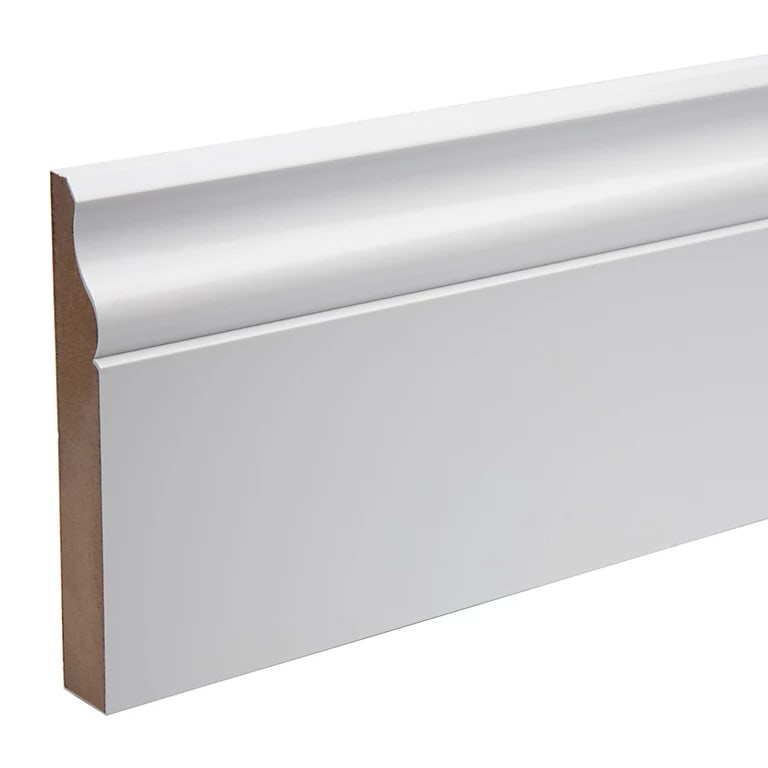Ogee Skirting Board
(8 Products)Ogee skirting boards are a popular choice for homeowners, builders, and decorators who want a classic finish that works across a range of interiors. With their soft curve and subtle detailing, they bring just the right amount of character without overpowering the room. You’ll find them in everything from period properties to new builds, adding shape and definition where walls meet floors.
What Are Ogee Skirting Boards?
Ogee skirting boards feature a distinctive curved profile that resembles an elongated “S” shape. This curved moulding has been around for hundreds of years, originally inspired by classical architecture, and it remains a favourite because of how easily it blends with both traditional and contemporary interiors.
You can get them in a range of sizes and materials. Some profiles are tall and bold, perfect for older properties with high ceilings. Others are slimmer and more understated, ideal for smaller rooms or contemporary spaces.
Most come in MDF, pine, or oak, depending on whether you’re planning to paint or leave the natural wood visible.
They hide gaps, protect the bottom edge of the wall, and just make everything feel that little bit more polished.
Why Choose Ogee?
- Classic appeal: The profile has that “familiar” feel many people associate with professional joinery work.
- Versatility: It fits almost any design style - painted white in a minimalist space or stained in a heritage property.
- Easy to match: Because it’s so widely used, it’s easy to find replacement pieces or matching architraves if you’re extending an existing look.
- Neat finish: Covers expansion gaps, protects the bottom of your walls, and pulls the room together.
Materials and Finishes
Ogee skirting boards come in a variety of materials to suit different budgets and project types. Each has its own pros and cons depending on what you’re after:
MDF (Medium Density Fibreboard): The most common option. It’s stable, smooth, and cost-effective. Primed MDF is great if you’re planning to paint it, and you won’t get knots or imperfections like you would with timber.
Softwood (Often Pine): A good mid-range option if you want something that can be painted or stained. Pine offers a more natural finish and is easier to sand and shape if needed.
Hardwood (Such As Oak): More expensive, but if you want a high-end, durable finish, solid oak ogee boards look stunning, especially in natural or lightly stained tones. Ideal for period renovations or luxury interiors.
You can usually choose from pre-primed, fully finished, or bare options, depending on whether you want to paint them yourself or install them ready to go.
Where Ogee Skirting Works Best
Honestly, it works almost everywhere. But here are a few common uses:
- Period properties: Ogee complements decorative cornices, picture rails, and older mouldings perfectly.
- Hallways and living rooms: Adds shape and character to the most visible areas of the home.
- New builds: If you want a step up from plain skirting without going full traditional, ogee hits that middle ground.
- Commercial interiors: Offices, hotels, and hospitality spaces often use ogee for its neat, non-distracting finish.
And if you're matching other mouldings, like door architraves, we supply a corresponding ogee architrave to keep everything consistent.
Choosing the Right Height and Thickness
There’s no one-size-fits-all answer, but here’s a rough guide:
- 90mm-120mm (standard) - Common in most modern homes, gives enough detail without overpowering a space.
- 145mm-190mm (tall) - Ideal for rooms with high ceilings or traditional design schemes.
- 15mm-25mm thickness - Thicker boards can feel more substantial and help with hiding uneven plasterwork or pipes behind.
When in doubt, order a couple of offcuts or samples and hold them up to the wall. It’s the easiest way to visualise how they’ll look once installed.
Installation Tips
- Measure twice, cut once - Ogee profiles are easy to work with, but corners and joins can be fiddly if you're not used to moulded shapes.
- Use adhesive and pins - Grip adhesives work well for MDF. Add a few pins for extra hold, especially on longer runs.
- Pre-paint or prime where possible - It’s easier to get a clean finish when you paint before fixing them in place.
- Caulk gaps - Fill between the wall and top edge with decorator’s caulk for a seamless look.
If you’re replacing old skirting, don’t forget to check what’s behind it - pipes, cables, or uneven walls might call for thicker profiles or some extra prep.
Frequently Asked Ogee Skirting Board Questions
Can I Paint Ogee Skirting Boards?
Absolutely. Most ogee skirting boards come either primed or bare, so you can paint them any colour you like. White or off-white is common, but darker tones can look great in period-style homes or more dramatic interiors.
Do Ogee Boards Come With Matching Architraves?
Yes, we offer matching architraves with the same ogee profile. That way, you can carry the same detail around your doors and windows, which helps create a more cohesive look throughout the space.
How Do I Fix Ogee Skirting To The Wall?
You can use grab adhesive, pins, or a combination of both. For plasterboard walls, adhesive is usually enough. If the wall isn’t perfectly straight, you might need to scribe the back of the board slightly so it sits flush. Always fill the top edge with decorator’s caulk to close the gap before painting.
What If I Need To Replace A Section - Will The New Ogee Match Old?
That depends on the profile. Some ogee mouldings are fairly standard, while others vary slightly in depth or curve. If you're replacing a small section, it’s worth taking a piece of the original with you when buying new so you can match it as closely as possible.



